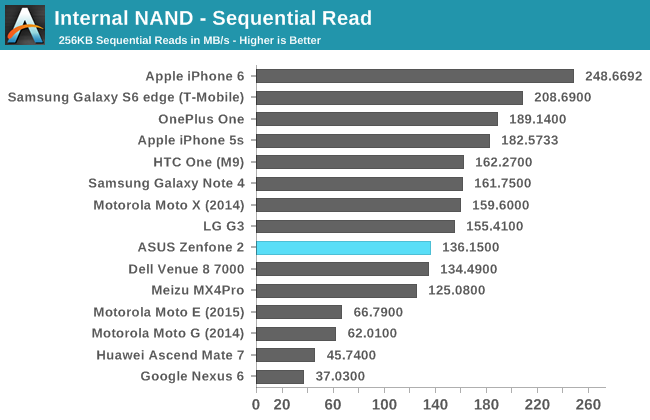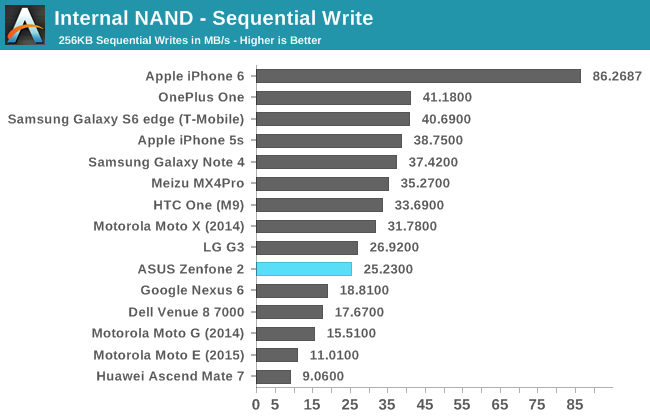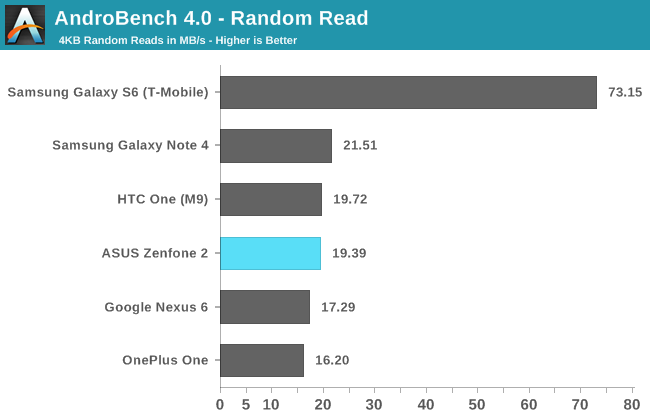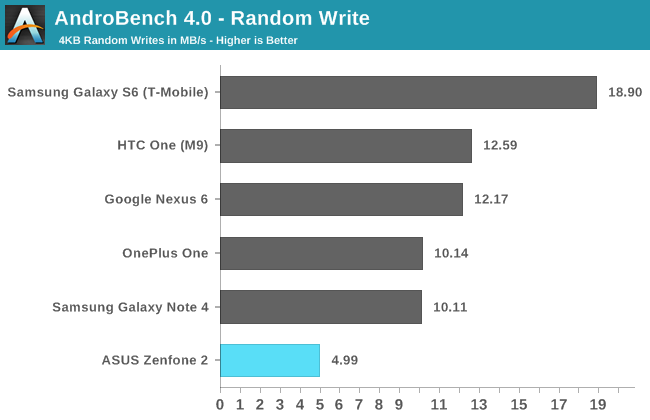The ASUS ZenFone 2 Review
by Brandon Chester on May 26, 2015 8:00 AM ESTNAND Performance
While it's not disclosed by manufacturers, the speed of NAND on a smartphone is a very important aspect of overall smartphone performance. It has an impact on how long cameras can do burst capture, and how well the phone performs when apps are running both in the foreground and the background. To evaluate the NAND performance of the ZenFone 2 I've run it through both of our internal storage benchmarks. Because our iOS benchmark only supports a single IO thread, we'll be using our older storage benchmark alongside the newer Androbench 4.0 test for the foreseeable future.




In our original single threaded storage benchmark the ZenFone 2 is decidedly average in its performance. In every case it's either slightly above or below the median result on our charts. It's important to keep in mind that this test puts devices like the Galaxy S6 with its UFS storage at a disadvantage, as its NAND can make use of several IO threads due to the use of a command queue.




In our newer AndroBench 4.0 storage test we see that the ZenFone 2 ends up falling farther behind the other devices that we've run through the test. In the sequential read test it's not the slowest device, but that's only due to the Nexus 6 being extremely far behind every other device as a result of Google's full disk encryption. In the sequential write and random read tests it's comes behind the HTC One (M9), although to a very small degree in the latter test. Random writes are where it really stumbles, with a speed that's less than half of the next slowest device.
I'm not sure whether I can attribute it to the enormous amount of RAM that the 4GB version of the ZenFone 2 can use as a cache, but I never noticed any issues with performance as a result of IO operations being run either by the app I was using or by another application in the background. Even when updating applications, performance remained consistent.










147 Comments
View All Comments
piaw - Tuesday, May 26, 2015 - link
I don't want Windows Phone on this, I want full on Windows 10 with a telephony app! This will eliminate the "app gap" (sure, might have to use desktop mode, but for something like say, Garmin Express, I don't need to even see the UI after installation). With 4GB of RAM, this will outrun any number of existing full Windows tablets!mkozakewich - Tuesday, May 26, 2015 - link
If needed, it's also possible to have Windows and Android on at the same time with a button on each desktop to switch to the other OS.(Unless MS was brilliant and enabled Continuum to switch from a Windows Phone UI to a Desktop UI?)
darkich - Tuesday, May 26, 2015 - link
The only possible reason why this is a $300 device, is the giveaway from Intel.Their most advanced Atom yet couldn't be sold for its real price and the fact that it can only compete with old 28nm and 20nm ARM chips explains why is that the case.
Speedfriend - Tuesday, May 26, 2015 - link
This isn't the most advanced Atom yet, it is the last generation phone SOC.Intel doesn't give away any chips, it helps OEMs use intel SOCs by contributing to the higher bill of materials that using an Intel SOC entailed. As it adds features to its SOC, the contra revenue will go down.
SunLord - Tuesday, May 26, 2015 - link
Technically this is the current generation phone SOC as they've not launched an airmont based phone SOC yetmenting - Tuesday, May 26, 2015 - link
The CPU being free or not won't make more than $50 difference though....lefty2 - Tuesday, May 26, 2015 - link
The ZenFone is cheap because of Intel's contra revenue scheme. Basically, Intel sells the SoC to Asus for $0.tipoo - Tuesday, May 26, 2015 - link
I read Asus ends up paying 5 dollars per chip rather than the 30+ some SoCs sell at, but yeah, close enough.CrazyElf - Tuesday, May 26, 2015 - link
For it's price, it's not a bad phone to be honest.I'd love to see what Asus can do in future generations and what a flagship that can rival high end phones like the Galaxy Note X would be able to pull off.
Equally interesting will be what future Intel SOCs do. I would like to see an even bigger GPU loaded onto the phone.
UltraWide - Tuesday, May 26, 2015 - link
What good is all this performance if the phone has ran out of batteries and you can't use it?